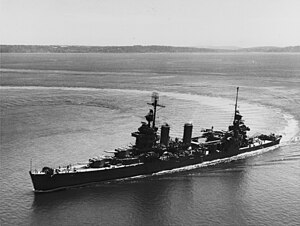
The Tennessee class consisted of two super-dreadnought battleships—Tennessee and California—built for the United States Navy in the late 1910s, part of the "standard" series. The class was in most respects a repeat of the preceding New Mexico class, with the primary improvements being a significantly strengthened underwater protection system, and increased elevation of the main battery guns to allow them to fire at much greater ranges. They carried the same main battery of twelve 14-inch (356 mm) guns in four triple turrets, and had the same top speed of 21 knots. Both ships served in the Pacific Fleet for the duration of their careers, which included an extensive training program during the interwar period of the 1920s and 1930s.

The heavy cruiser was a type of cruiser, a naval warship designed for long range and high speed, armed generally with naval guns of roughly 203 mm (8 inches) in calibre, whose design parameters were dictated by the Washington Naval Treaty of 1922 and the London Naval Treaty of 1930. The heavy cruiser is part of a lineage of ship design from 1915 through the early 1950s, although the term "heavy cruiser" only came into formal use in 1930. The heavy cruiser's immediate precursors were the light cruiser designs of the 1900s and 1910s, rather than the armoured cruisers of the years before 1905. When the armoured cruiser was supplanted by the battlecruiser, an intermediate ship type between this and the light cruiser was found to be needed—one larger and more powerful than the light cruisers of a potential enemy but not as large and expensive as the battlecruiser so as to be built in sufficient numbers to protect merchant ships and serve in a number of combat theatres.

USS New York (ACR-2/CA-2) was the second United States Navy armored cruiser so designated; the first was the ill-fated Maine, which was soon redesignated a second-class battleship. Due to the unusually protracted construction of Maine, New York was actually the first armored cruiser to enter U.S. Navy service. The fourth Navy ship to be named in honor of the state of New York, she was later renamed Saratoga and then Rochester. With six 8-inch guns, she was the most heavily armed cruiser in the US Navy when commissioned.

The armored cruiser was a type of warship of the late 19th and early 20th centuries. It was designed like other types of cruisers to operate as a long-range, independent warship, capable of defeating any ship apart from a battleship and fast enough to outrun any battleship it encountered.

USS Quincy (CL/CA-39) was a United States Navy New Orleans-class cruiser, sunk at the Battle of Savo Island in 1942.

The third USS Astoria was a Cleveland-class light cruiser of the United States Navy, which were built during World War II. The class was designed as a development of the earlier Brooklyn-class cruisers, the size of which had been limited by the First London Naval Treaty. The start of the war led to the dissolution of the treaty system, but the dramatic need for new vessels precluded a new design, so the Clevelands used the same hull as their predecessors, but were significantly heavier. The Clevelands carried a main battery of twelve 6-inch (152 mm) guns in four three-gun turrets, along with a secondary armament of twelve 5 in (127 mm) dual-purpose guns. They had a top speed of 32.5 knots.
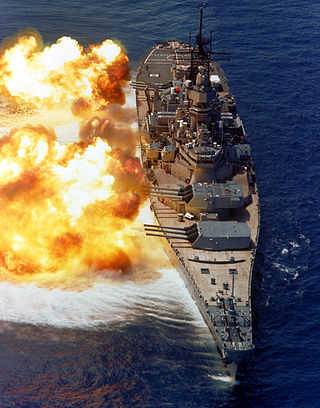
The Iowa class was a class of six fast battleships ordered by the United States Navy in 1939 and 1940. They were initially intended to intercept fast capital ships such as the Japanese Kongō class while also being capable of serving in a traditional battle line alongside slower battleships and act as its "fast wing". The Iowa class was designed to meet the Second London Naval Treaty's "escalator clause" limit of 45,000-long-ton (45,700 t) standard displacement. Four vessels, Iowa, New Jersey, Missouri, and Wisconsin, were completed; two more, Illinois and Kentucky, were laid down but canceled in 1945 and 1958, respectively, before completion, and both hulls were scrapped in 1958–1959.

The Wyoming class was a pair of dreadnought battleships built for the United States Navy. Wyoming and Arkansas were authorized in early 1909, and were built between 1910 and 1912. These were the fourth dreadnought design of the US Navy, but only an incremental improvement over the preceding Florida class, and the last US battleships to use 12-inch guns. The primary changes were the adoption of a more powerful 12 in (305 mm)/50 caliber Mark 7 gun, addition of a sixth twin-gun turret and improved armor protection, including the first use of a torpedo bulkhead on American battleships. The Navy considered using more powerful 14-inch (356 mm) guns, but this would have caused delays and required larger docks.

The 16"/50 caliber Mark 7 – United States Naval Gun is the main armament of the Iowa-class battleships and was the planned main armament of the cancelled Montana-class battleship.

The Atlanta-class cruisers were eight United States Navy light cruisers which were designed as fast scout cruisers or flotilla leaders but which proved to be effective anti-aircraft cruisers during World War II. They were also known as the Atlanta-Oakland class. The Atlanta class originally had 16 x 5-inch (127 mm)/38 caliber guns in eight two-gun turrets, arranged with three superfiring turrets forward, three more superfiring aft and two waist mounts, one port and one starboard, giving the first four Atlanta-class cruisers the heaviest anti-aircraft armament of any cruiser of World War II. The last four ships of the class, starting with Oakland, had a slightly revised armament with a reduced main gun battery - the waist turrets being deleted - as they were further optimized for anti-aircraft fire in light of war experience.
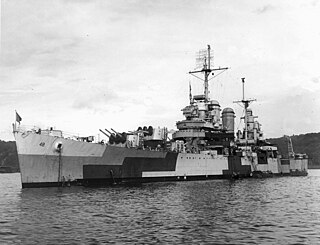
The Brooklyn-class cruiser was a class of nine light cruisers built for the United States Navy between 1935 and 1938. Armed with five triple 6-inch (152 mm) gun turrets, they mounted more main battery guns than any other standard US cruiser. The Brooklyn-class ships were all commissioned between 1937 and 1939, in the time between the start of the Second Sino-Japanese War and before the invasion of Poland. They served extensively in both the Pacific and Atlantic theaters during World War II.

The Portland class of heavy cruisers was a class of ships designed and constructed by the United States Navy in 1930. The two ships of the class, Portland and Indianapolis, saw extensive service during the Pacific War in World War II.

The Pennsylvania class of six armored cruisers served in the United States Navy from 1905 to 1927. All six were renamed for cities 1912–1920, to make the state names available for the new battleships beginning with the Pennsylvania-class battleships. All of these served during World War I, with California being the only ship of the class to be lost. The remaining five armored cruisers were scrapped between 1930 and 1931 in accordance with the London Naval Treaty.

The Sverdlov-class cruisers, Soviet designation Project 68bis, were the last conventional gun cruisers built for the Soviet Navy. They were built in the 1950s and were based on Soviet, German, and Italian designs and concepts developed prior to the Second World War. They were modified to improve their sea capabilities, allowing them to operate at high speeds in the rough waters of the North Atlantic.

The South Dakota class was a group of four fast battleships built by the United States Navy. They were the second class of battleships to be named after the 40th state; the first were designed in the 1920s and canceled under the terms of the Washington Naval Treaty. Four ships comprised the class: South Dakota, Indiana, Massachusetts, and Alabama. They were designed to the same treaty standard displacement limit of 35,000 long tons (35,600 t) as the preceding North Carolina class and had the same main battery of nine 16"/45 caliber Mark 6 guns in three-gun turrets, but were more compact and better protected. The ships can be visually distinguished from the earlier vessels by their single funnel, compared to twin funnels in the North Carolinas.
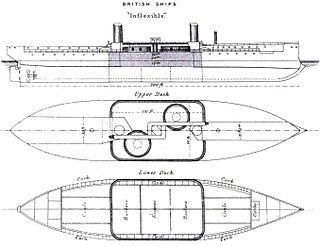
All or nothing is a method of naval warship armor, best known for its employment on dreadnought battleships. The concept involves heavily armoring the areas most important to a ship while the rest of the ship receives no armor. The "all or nothing" concept avoided light or moderate thicknesses of armor: armor was used in the greatest practicable thickness or not at all, thereby providing "either total or negligible protection". Compared to previous armoring systems, "all or nothing" ships had thicker armor covering a smaller proportion of the hull.

The 5"/25 caliber gun entered service as the standard heavy anti-aircraft (AA) gun for United States Washington Naval Treaty cruisers commissioned in the 1920s and 1930s. The goal of the 5"/25 design was to produce a heavy AA gun that was light enough to be rapidly trained manually. The gun was also mounted on pre-World War II battleships and aircraft carriers until replaced by the standard widespread dual-purpose 5"/38 caliber gun, which was derived from the 5"/25. Guns removed from battleships were probably converted for submarine use by late 1943, while a purpose-built variant for submarines was available in mid-1944, and was widely used by them. United States naval gun terminology indicates the gun fired a projectile 5 inches (127 mm) in diameter, and the barrel was 25 calibers long. It is referred to sometimes as a dual purpose gun and sometimes as an anti-aircraft gun, because of its comparative weakness against surface targets.

The St. Louis-class cruisers were a class of three cruisers that served in the United States Navy at the beginning of the 20th century. Authorized in fiscal year 1901 by an Act of Congress of 7 June 1900 as part of the naval buildup touched off by the Spanish–American War, the St. Louis-class cruiser initially began as an improved Olympia. However, during the design phase, decisions were made that increased the size of the vessel from 6,000 long tons (6,100 t) to 9,700 long tons (9,900 t), including adding protection that resulted in the designation "semi-armored cruiser". This led to a larger power plant, and other decisions were made to try to increase speed and range, such as using smaller 6-inch (152 mm) guns instead of 8-inch (203 mm) guns, and adding coal capacity. The completed ship at 9,700 long tons was the same displacement as a full armored cruiser without the same armor. One reference describes the class as "among the earliest well-documented examples of creeping growth in warship design".

The Ibuki class, also called the Kurama class, was a ship class of two large armoured cruisers built for the Imperial Japanese Navy after the Russo-Japanese War of 1904–1905. These ships reflected Japanese experiences during that war as they were designed to fight side-by-side with battleships and were given an armament equal to, or superior to existing Japanese battleships. The development of the battlecruiser the year before Ibuki was completed made her and her sister ship Kurama obsolete before they were completed because the foreign battlecruisers were much more heavily armed and faster.
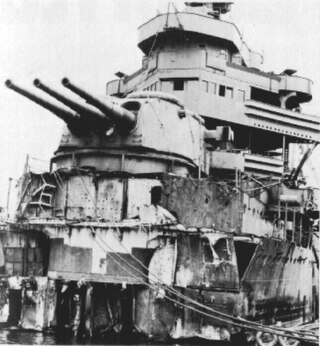
The 8"/55 caliber gun formed the main battery of United States Navy heavy cruisers and two early aircraft carriers. United States naval gun terminology indicates the gun barrel had an internal diameter of 8 inches (203 mm), and the barrel was 55 calibers long.
